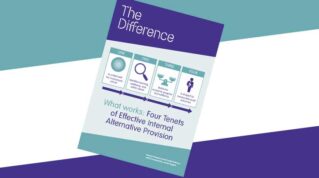Learning mathematics can be hard. Teaching mathematics – and teaching it well – can be harder still. My latest research paper Understanding mathematics anxiety: Loss-aversion and student engagement uses behavioural economics to help teachers understand maths anxiety and come up with practical ways to help students overcome it.
In the paper, I explore how loss-aversion, a pervasive bias in human behaviour, is likely to affect student engagement with mathematical content in a wide range of subjects like business, chemistry, economics, engineering, finance and physics.
Loss-aversion is a psychological phenomenon where losses hurt about twice as much as the gains can make us feel good. If students perceive failure to correctly complete a maths exercise as psychologically, socially or emotionally costly, then loss-aversion is likely to bias their study decisions towards disengagement in behaviour that is consistent with maths anxiety.
The paper uses these insights to construct a model of student engagement which shows that students with low maths preparedness are at heightened risk of falling into a vicious cycle of low attainment and disengagement due to maths anxiety.
But what can teachers do to help students overcome maths anxiety? A wealth of research in behavioural economics suggests that positive framing can be a powerful tool to counteract the effects of loss-aversion.
In keeping with these findings, the theory of maths anxiety developed in the paper finds that pedagogic interventions to improve negative associations with the threat of failure are likely to help students overcome maths anxiety.
In contrast, interventions that rely on negative framing, such as reminding students of the consequences of failure, reprimanding students for failure and punishing students in a way that is visible to their peers are likely to worsen anxiety and disengagement.
Positive framing can be a powerful tool
Steps to ‘gain-frame’ the threat of failure in the classroom have the potential to improve engagement among anxious students. This includes casting home- and class-work exercises as a ‘safe space’ for trial and error.
In my own experience teaching cohorts of 900 business school students mathematical content in an introductory economics module, I found it very helpful to reassure students that making mistakes is just a part of learning mathematical tasks. Such measures can rehabilitate the sensitivities of students for whom the threat of failure looms large.
The theory developed in the paper helps understand why positive pedagogies informed by ‘achievement goal theory’ and the related ‘growth mindset theory’ can be successful in improving student engagement.
In achievement goal theory, ego-oriented goals measure performance relative to a peer group, whereas task-oriented goals focus on improving one’s own performance over time. As a result, with task-oriented goals, failure represents an opportunity to improve and so might not trigger negative associations.
Growth mindset theory distinguishes between learners with fixed mindsets and those with growth mindsets. With a fixed mindset, mathematical ability is viewed as an unchanging endowment and so failure can only be perceived negatively. This is not so under a growth mindset where the experience of failure is framed as an input to learning and a way to track growth. Thus, actively encouraging task-oriented goals and a growth mindset can help students overcome mathematics anxiety.
The paper identifies an important role for adaptive learning technologies to help students overcome mathematics anxiety. Dynamic difficulty adjustment, a technique from video game design that is used to increase engagement, has the potential to allow the development of programmes which adjust the difficulty of mathematical exercises in real time to match student ability. This would permit problems to be kept difficult enough to foster learning, but not so difficult as to trigger anxiety and disengagement.
It might seem reasonable for an educator to surmise that chronic disengagement in a student is indicative of chronic apathy. My research on maths anxiety suggests otherwise. Some students might disengage because they are overly concerned by the threat of failure. The positive pedagogies outlined above might help such students to reengage.











Growth mindset is pseudoscience. Stop perpetuating its myth.